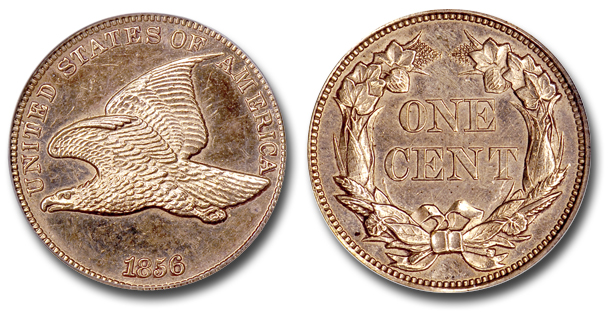
After the Act of February 21, 1857, discontinued the large copper cent, announcements were made, and a wave of nostalgia swept across the nation. Thousands of people desired to find as many dates of large copper coins as possible, looking through change, drawers, and other places. At the time it was possible to obtain all dates from circulation, except for 1815, which was not minted. Cents dated 1799 were particularly rare, and of special significance were those well-worn pieces made in 1793.
Interest in collecting grew and there arose a demand for the pattern 1856 Flying Eagle cents. There were few to be had, and anyone lucky enough to own one was apt to be able to get $2 for it. In terms of buying power, that was more than equal to a day’s wage at the time. Desiring to accommodate collectors and also to privately make a profit, certain Mint officials began restriking 1856 Flying Eagle cents and other coins in the spring of 1859. The restrikes, with Proof finish, added perhaps 2,000 or more pieces to the supply.
From that day forward 1856 Flying Eagle cents have been in strong demand, increasing steadily in value over the years. The number existing can only be guessed at, but may be around 2,000 pieces. Today in 2013 these typically appear on the market one at a time and always attract attention when they do.
The preceding said, you may enjoy the following:
In the late 19th and early 20th centuries several numismatists thought it good sport to hoard as many 1856 Flying Eagle cents as possible. A great sport, this!
The first extensive study of such hoards was published by John F. Jones in The Numismatist, April 1944. This was a key resource during my preparation of the present commentary. Other events since 1944 round out the picture.
R.B. Leeds, of Atlantic City, NJ, began collecting these in the 19th century. Henry Chapman auctioned the Leeds Collection on November 17 and 28, 1906, and included this in his commentary:
“For many years he was an ardent collector, turning his attention to accumulating all the examples he could of certain dates, his especial hobby being 1856 Eagle cents of which he had 109 specimens, the greatest collection ever offered of this very rare cent. Mr. Leeds was a firm believer in the rarity and value of this coin, and bought all that he could for many years past. The advance of the past 10 years has proved his judgment to have been correct.”
Proofs sold from $8 to $10.50; Uncirculated, from $6 to $10; Very Fine to nearly Uncirculated $5.50 to $6.50; Good and Very Good, $4 to $5.50.
George W. Rice, a wealthy building contractor in Detroit, began collecting coins in 1864. At an early time he took a fancy to 1856 Flying Eagle cents. By the early 20th century he had obtained 756 examples — far and away the largest hoard ever! This was not at all pleasing to Commodore W.C. Eaton, who penned a letter to The Numismatist, July 1916, stating that Rice’s numismatic gluttony made the current price of $5 for a specimen “absolutely absurd…for anything under a brilliant Proof,” and that such activity was “quite contrary to proper ethics.” Rice’s cents seem to have been sold privately, as no catalog of them has ever been found.
The best-known hoard of 1856 Flying Eagle cents was that formed by John Andrew Beck of Pittsburgh. Born in Chestnut Ridge, Pennsylvania, on January 5, 1859, Beck spent part of his youth with his parents in Texas, but the family was forced return to Pennsylvania in face of Indian depredations in the West. His father developed brine wells near Pittsburgh, from which liquid salt was taken, developing into a large wholesale business in that commodity. He also drilled for oil. Upon his father’s death, John eventually acquired the business. He collected his first scarce and rare coins at the age of 10. The passion continued, and into the late 19th century he bought territorial gold coins (including dozens of octagonal $50 pieces), large quantities of Mint State $3 coins, and many other coins, including 1856-dated Flying Eagle cents, mostly from the Chapman brothers and, after 1906, from Henry Chapman. It seems that along the way he acquired many coins from the Leeds hoard. At one time he posted a standing offer of $10 for any 1856 Flying Eagle cent regardless of grade.
Beck died on January 27, 1924. His estate was handled by the Pittsburgh National Bank & Trust Company, of which he had been a director. An inventory revealed 531 Flying Eagle cents. Although many coin dealers knocked on the bank’s door, Beck’s vast coin collection remained intact, Finally, in the early 1970s the administrators turned over the coins to Abner Kreisberg and Jerry Cohen, of Beverly Hills, to sell in the best manner they saw fit. Most of gold coins and other rarities were sold at auction but Jerry and Abner decided that most of the Flying Eagle cents would be best sold by private sale.
When the cents arrived at their office I was among the first to see them. All of them had a rather dull appearance, “vault grime” so to speak, from numismatic inattention for decades. However, some basic dipping in acetone, a solvent that simply removes dirt and grease, did wonders, and the coins regained their original appearance. It was thought that the availability of hundreds of pieces would dampen the market, but the opposite proved to be true. The coin hobby was in a period of great strength at the time, all of the 1856 Flying Eagle cents found ready buyers, and the price increased!





